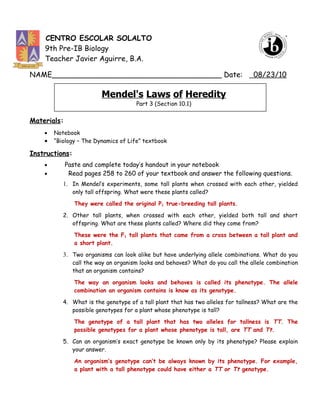
9th Pre-IB Biology Mendel's Laws of Heredity Part 3
- 1. CENTRO ESCOLAR SOLALTO 9th Pre-IB Biology Teacher Javier Aguirre, B.A. NAME_____________________________________ Date: 08/23/10 Mendel's Laws of Heredity Part 3 (Section 10.1) Materials: • Notebook • “Biology – The Dynamics of Life” textbook Instructions: • Paste and complete today’s handout in your notebook • Read pages 258 to 260 of your textbook and answer the following questions. 1. In Mendel’s experiments, some tall plants when crossed with each other, yielded only tall offspring. What were these plants called? They were called the original P1 true-breeding tall plants. 2. Other tall plants, when crossed with each other, yielded both tall and short offspring. What are these plants called? Where did they come from? These were the F1 tall plants that came from a cross between a tall plant and a short plant. 3. Two organisms can look alike but have underlying allele combinations. What do you call the way an organism looks and behaves? What do you call the allele combination that an organism contains? The way an organism looks and behaves is called its phenotype. The allele combination an organism contains is know as its genotype. 4. What is the genotype of a tall plant that has two alleles for tallness? What are the possible genotypes for a plant whose phenotype is tall? The genotype of a tall plant that has two alleles for tallness is TT. The possible genotypes for a plant whose phenotype is tall, are TT and Tt. 5. Can an organism’s exact genotype be known only by its phenotype? Please explain your answer. An organism’s genotype can’t be always known by its phenotype. For example, a plant with a tall phenotype could have either a TT or Tt genotype.
- 2. 6. When is an organism classified as homozygous? Is a true-breeding plant homozygous? Is a short plant homozygous? Please explain your answers. An organism is homozygous for trait it the two alleles for that trait are the same. A short plant would always have two alleles for shortness (tt). It would, therefore, always be homozygous recessive for the trait of height. 7. Look at Figure 10.5. Please identify the phenotype and genotype of each plant. F1: Phenotype for both plants = Tall / Genotype for both plants = Tt F2: Phenotype for the first three plants = Tall; phenotype for the 4th plant = short / Genotype for the first plant = TT; genotype for the 2nd and 3rd plant = Tt; genotype for the last plant = tt 8. What do we call crosses in which the organisms crossed differ from each other in two traits? Why? This type of cross is called a dihybrid cross because di means “two”. 9. What types of plants did Mendel use for his dihybid crossing experiment? What were the phenotypes of the two parent (P) plants? Mendel took true-breeding pea plants that had round yellow seeds (RRYY) and crossed them with true-breeding plants that had wrinkled green seeds (rryy). 10. What did Mendel observe in the F1 generation of this dihybrid crossing experiment? What did he observe in the F2 generation? F1 generation: Mendel already knew that when he crossed plants that produced round seeds with plants that produced wrinkled seeds, all the plants in the F1 generation produced seeds that were round. In other words the round seeded trait was dominant to the wrinkled-seeded trait. Similarly, when he crossed plants that produced yellow seeds with plants that produced green seeds, all the plants in the F1 generation produced yellow seeds – yellow was dominant. Therefore, Mendel was not surprised when he found that the F 1 plants of his dihybrid cross all had the two dominant traits of round and yellow seeds. F2 generation: Mendel then let F1 plants pollinate themselves. He found some plants that produced round yellow seeds and others that produced wrinkled green seeds. But that was not all. He also found some plants with round green seeds and others with wrinkled yellow seeds. When Mendel sorted and counted the plants of the F2 generation, he found they appear in a definite ratio of phenotypes – 9 round yellow: 3 round green: 3 wrinkled yellow: 1 wrinkled green.
- 3. • Homework: 1. Please reproduce Figure 10.6 in your notebook. 2. Please explain the word origin of the following word: phenotype, genotype and heterozygous. Phenotype: From the Greek words phainein, meaning “to show”, and typos, meaning “model”. The visible characteristics of an organism make up its phenotype. Genotype: From the Greek words gen or geno, meaning “race” and typos, meaning “model”. The allele combination of an organism makes up its genotype. Heterozygous: From the Greek words heteros, meaning “other”, and zygotes, meaning “joined together”. A trait is heterozygous when an individual has two different alleles for that trait.
